All you need to know about your products!

| 3DNews Vendor Reference English Resource - All you need to know about your products! |
||||||
 |
||||||
|
|
||||||
GeXcube Radeon 9600XT ExtremeAuthor:Date: 27/02/2004
Introduction
Info-Tek Corp. Taiwan, and its GeXcube brand of graphic products are still little known in Russia, and it makes sense telling a bit more about them. The company was established in 1990 as a developer and supplier of solely video cards. To date, these are only cards built on ATI chips, and the company is not going to change such strategy. 22% of the company property is owned by IT specialists of GIGABYTE, with the major package of shares owned by a Taiwanese millionaire investor. The management, marketing, engineering and quality assurance services are based in a united building within the numerous techno-parks of Taipei, by the way, in the same building where AOpen are based. The manufacture of products is performed at one of the four factories of Info-Tek in China. 
Anyway, something's going wrong with the company name - the website address is www.gecube.com.tw, the brand on the boxes says GeXcube, and the nameplate on the wall says it's premises by "GIGAXCUBE" that belongs to Info-Tek Corp and partly is a division of GIGABYTE. In short, the Chinese chaos :-) You can get an idea of the full line of GeXcube video cards on the company's product page. That's already an official line currently being manufactured. Our "guinea-pig" is still not there. Inside the laboratory, there was developed a secret project dubbed GeXcube Radeon 9600XT Extreme - an advanced version of 9600XT with increased memory operating frequencies. The thing is that ATI Radeon 9600XT in its reference design cannot compete on par with NVIDIA GeForce FX5700 Ultra, which we saw in the review GeForce FX5700 Ultra. The work of NVIDIA for the middle-end sector of the market proved to be much more powerful. So the only possible competition remains in the pricing pressure. GIGAXCUBE, a faithful follower of ATI, did not undergo such state of affairs and decided to rescue ATI's reputation on their own :-) So, we'll find it out how they succeeded in managing the posed task.
|
|||||||||||||||||||||||||||||||||||||||||||||||||||||||||||||||||||||
| CPU | P4 2.4Mhz 800FSB (Northwood D1) |
| Mb | Epox 4PDA2+ (i865PE) |
| Memory | PC2700 2x256Mb 400Mhz in the dual-channel mode Latency timings - 2:6:3:3 |
| Video cards |
NVIDIA FX5700 Ultra GeXcube Radeon 9600XT Extreme ASUS Radeon 9600XT ATI Radeon 9600Pro |
| OS | WinXP + SP1 |
| Drivers |
Detonator 53.03 Catalyst 3.10 |

Test software:
Old games:
New games:
The video card was overclocked with the RivaTuner utility. The operation stability in overclocking was verified with the comprehensive benchmark Aquamark3. First, the memory was overclocked. The maximum attained value is 800 MHz, which is a standard operation mode for the 2.5 ns memory. Probably, such weak memory overclocking is a result of placing that 1-mm thick chewing gum as the thermal interface. Since during the normal cooling of this type of memory it works fine even at 860 MHz. (The record value attained was 920 MHz, but for that I had to use two fans, which is unacceptable in normal conditions).
Then, the most interesting occurred - with the memory set to 800 MHz, the core wouldn't run in the overclocked mode at all. That is, the system was overheating and then hung at the very start of the test. I even had to revert the memory speed to the original 700 MHz and try overclocking the core separately. In the end, I produced the following values:
| Aquamark3 AFx4 1024x768 |
700Mhz Mem | 750Mhz Mem | 800Mhz Mem | 810Mhz Mem |
| 500 Mhz Core | 31719 | 32157 | 32391 | artifacts |
| 513 Mhz Core | 32307 | |||
| 526 Mhz Core | 32800 | |||
| 540 Mhz Core | 33318 | |||
| 553 Mhz Core | 33743 | |||
| 567 Mhz Core | 34203 | |||
| 580 Mhz Core | 34626 | |||
| 594 Mhz Core | hang |
Even the first step of overclocking the core (513 MHz) allowed to reach values attained through the maximum memory overclocking. Then the gap was only expanding...

Overclocking findings: the best combination for attaining the maximum performance of the card is overclocking the core leaving the memory as is. A curious finding, isn't it? Considering the operation margin for the memory.
By no means we urge our readers to overclock their cards and put their money at risk. All in all, we torture the specimens just to prevent you from doing that and warn you of not exceeding "some critical values". Otherwise, you will smell the so familiar scent of burnt chips, so God forbid..
The "overclocking" section in reviews is meant for one purpose only - to determine the work capacity of a video card recommended by the developers and thus its operational stability, longevity and reliability. The less the work capacity margin, the better. As you see, "GeXcube Radeon 9600XT Extreme" has of substantial performance margin.
All the further tests were performed under nominal operating modes of the core and memory of video cards participating the boards.

As we can see, "GeXcube Radeon 9600XT Extreme" was able to catch up with "NVIDIA FX5700 Ultra". Remember that it was attained through the departure of the "canonical standard" defined by ATI for video cards of XT series by merely 100 MHz of the memory frequency.
Here is a detailed view of results produced in 3DMark 2003 v340:
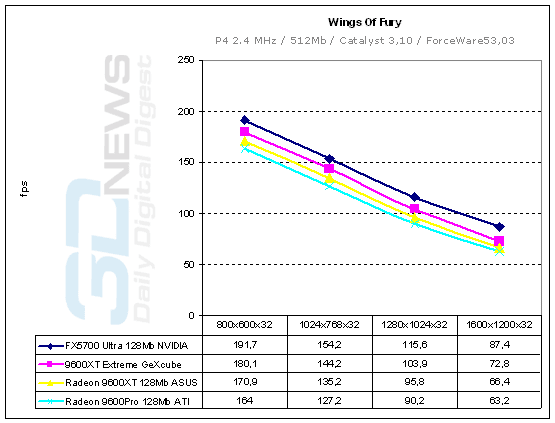
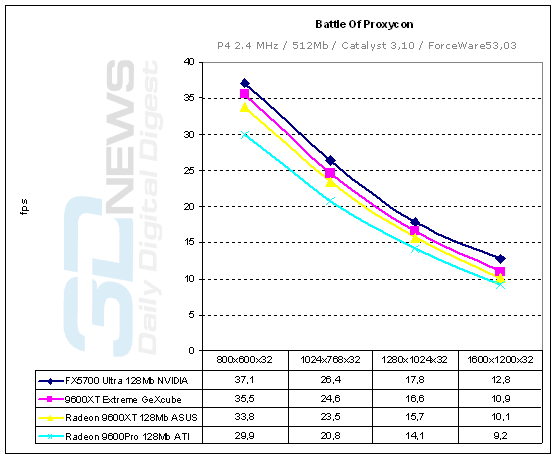

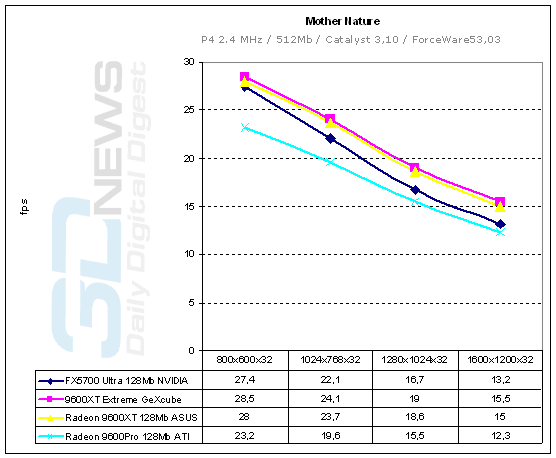

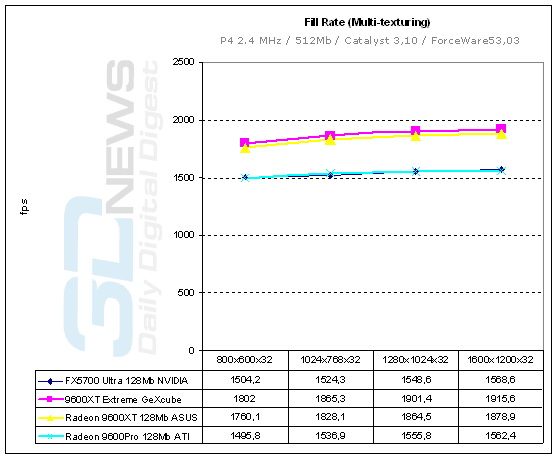


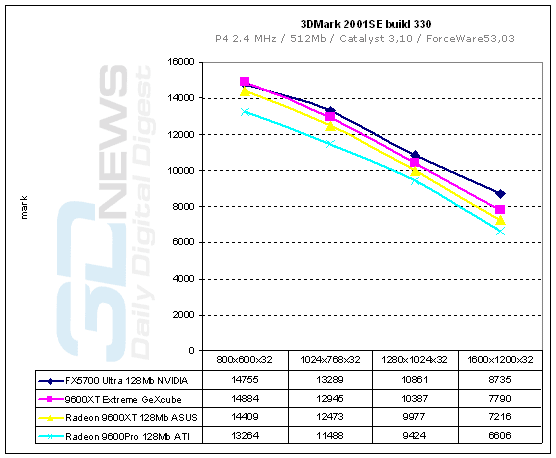
Let's run a test imagining there is no DX9 at all. Then we get the following. FX5700 Ultra and Radeon 9600XT Extreme start up very close to one another, but the "margin of safety" in NVIDIA produce is greater - the use of DDR2 memory makes itself felt.
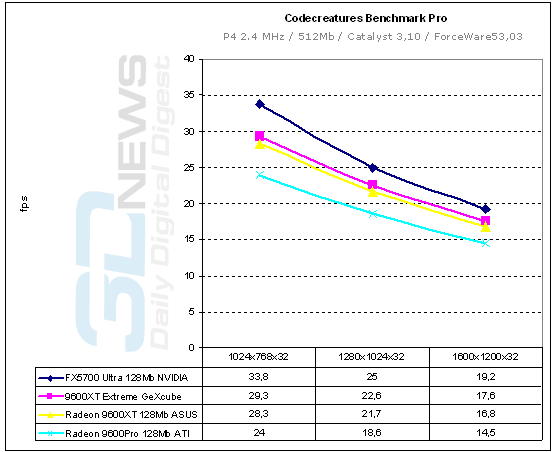
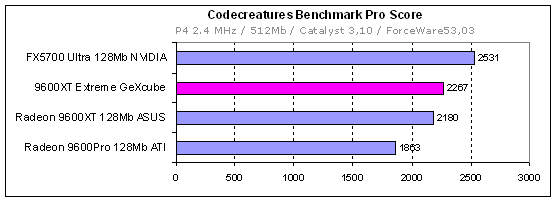
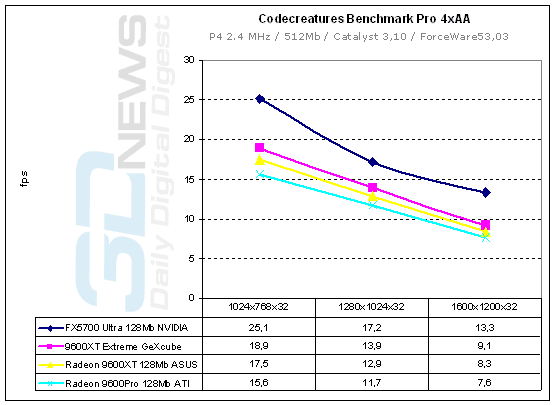
The small performance boost in the Extreme version is achieved, which is definitely not enough to compete with FX5700 Ultra.

This is a benchmark measuring the efficiency of invisible surfaces cut-off. The result for GeXcube and standard XT is the same, and the ATI RV360 does a better job coping with this task than the NV36.
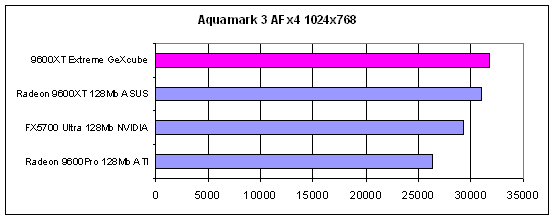
This benchmark was created in close cooperation with NVIDIA. But to some reason it's just this benchmark that shows not the best with their video cards.
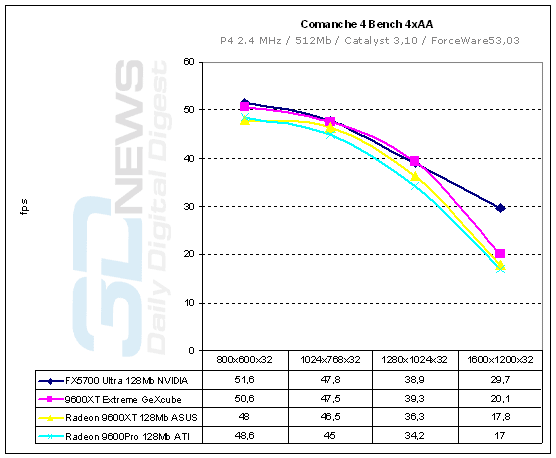
Wow! In the two most popular resolutions, the new kid "Extreme" and the champion FX5700Ultra are on par.
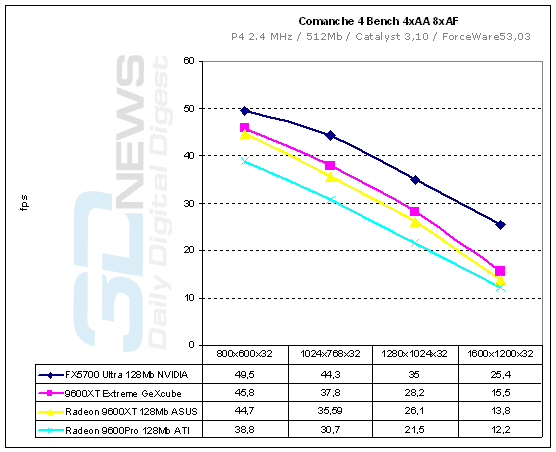
Among the advantages of NVIDIA cards is of course the less performance drop under aggressive quality settings.



This is a favorite game for most game fanciers. Our both competitors are about on par at that.
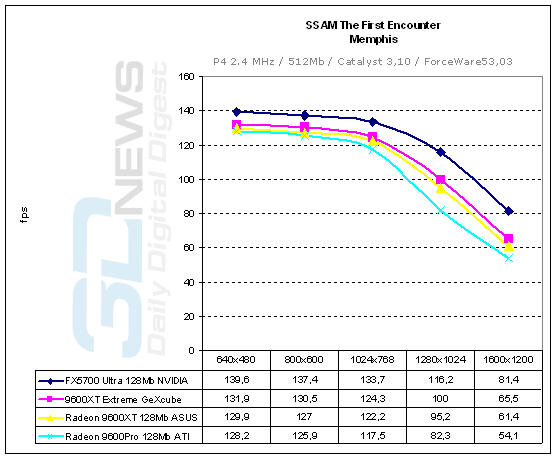
This is an OpenGL test. NVIDIA takes a lead.
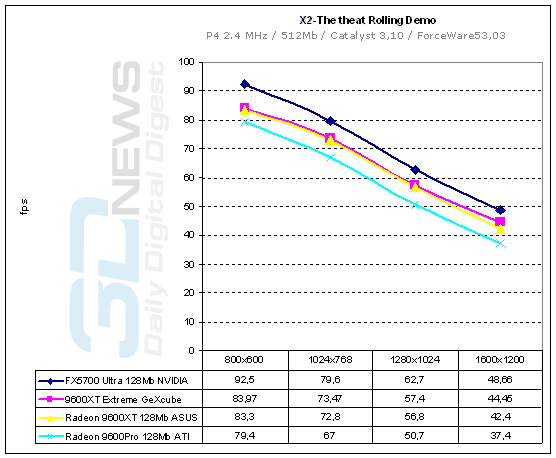
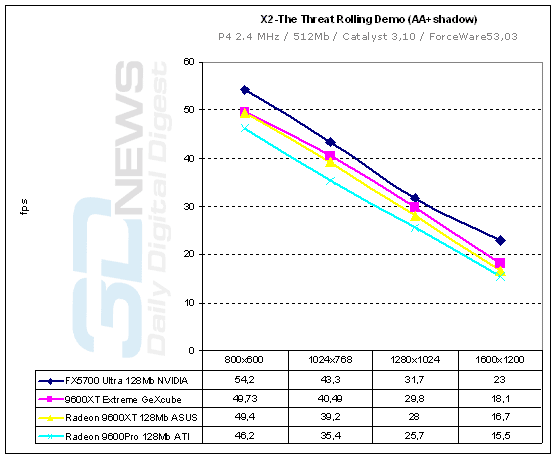
The "Ultra Shadows" technology implemented on the NVIDIA GeForce FX 5700 Ultra chip does a much better job handling the stencil shades.
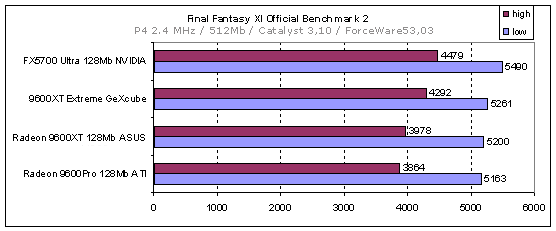
In this benchmark, all depends mainly on the fill-rate. The "Extreme" version failed to catch up with GeForce FX 5600 Ultra, albeit added enough score points as compared to the traditional Radeon 9600XT.
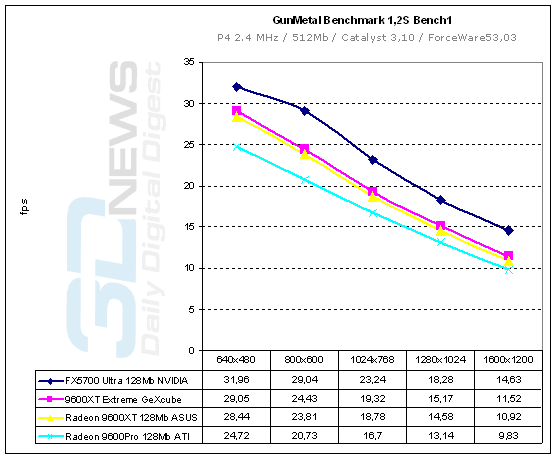
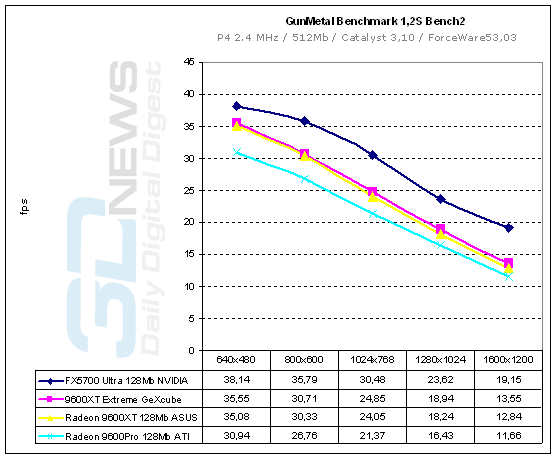
A test of implementation efficiency for version 1.1 pixel shaders. NVIDIA takes a lead.
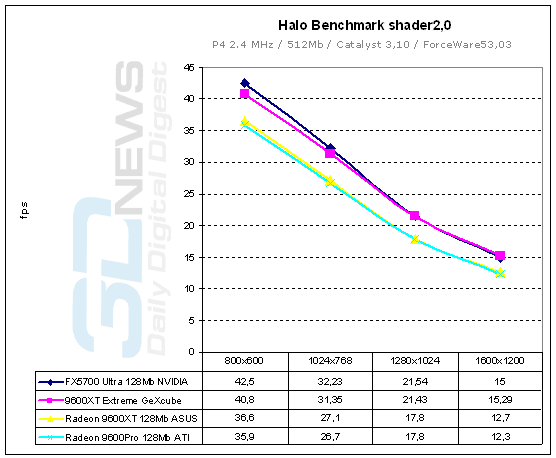
A test of implementation efficiency for version 2.0 pixel shaders. That's a surprise, isn't it? :) Our "guinea-pig" rushed forward and caught up with FX 5700 Ultra!
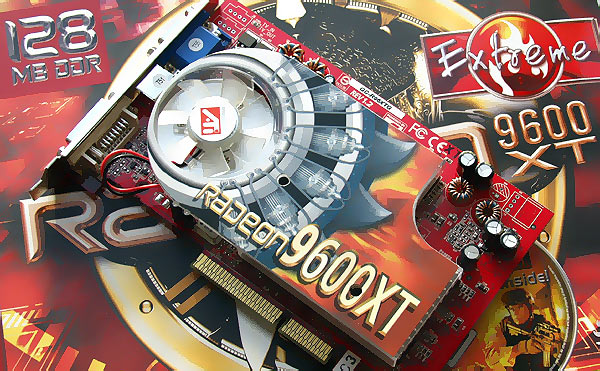
 Already after the first tests of GeForce FX5700 Ultra it became evident that NVIDIA decided to gain revenge at any price. Its direct competitor, Radeon 9600XT lost at all the benchmarks (except AquaMark 3 and Village Mark).
Already after the first tests of GeForce FX5700 Ultra it became evident that NVIDIA decided to gain revenge at any price. Its direct competitor, Radeon 9600XT lost at all the benchmarks (except AquaMark 3 and Village Mark).
"Regain the reputation at any price!" - even at the expense of income drop per sales unit (GeForce FX5700 Ultra is much more costly to produce than Radeon 9600XT). The difference was such that it was hard to imagine a card on the base of RV360 can be created to approach the NV36. But GigaXcube did that. The card takes quite an honorable place in the common line thus shrinking the gap between the yesterday's high-end and today's mainstream:
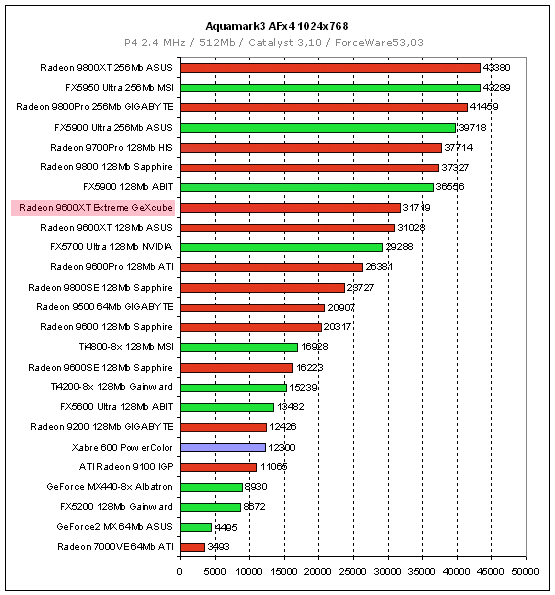
But if the cooling system is modified, then the overclockers will get a true pleasure watching the results of their skilful hands.
The "GeXcube Radeon 9600XT Extreme" only in a day or two may hit the retail. Therefore, its "unofficial price" has not yet been announced so far. Reminding it that today's price for a standard Radeon 9600XT is somewhere within 200-210$.
Pros:
The GeXcube Radeon 9600XT Extreme video was granted by GigaXcube
GeForce FX5700 Ultra - by NVIDIA
ASUS Radeon 9600XT was presented by ASUS
|
|||||